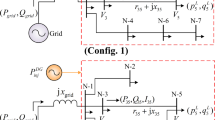Abstract
We propose novel techniques to find the optimal location, size, and power factor of distributed generation (DG) to achieve the maximum loss reduction for distribution networks. Determining the optimal DG location and size is achieved simultaneously using the energy loss curves technique for a pre-selected power factor that gives the best DG operation. Based on the network’s total load demand, four DG sizes are selected. They are used to form energy loss curves for each bus and then for determining the optimal DG options. The study shows that by defining the energy loss minimization as the objective function, the time-varying load demand significantly affects the sizing of DG resources in distribution networks, whereas consideration of power loss as the objective function leads to inconsistent interpretation of loss reduction and other calculations. The devised technique was tested on two test distribution systems of varying size and complexity and validated by comparison with the exhaustive iterative method (EIM) and recently published results. Results showed that the proposed technique can provide an optimal solution with less computation.
Similar content being viewed by others
References
Abu-Mouti, F.S., El-Hawary, M.E., 2011. Heuristic curve-fitted technique for distribution generation optimization in radial distribution feeder systems. IET Gener. Transm. Distr., 5(2):172–180. [doi:10.1049/iet-gtd.2009.0739]
Acharya, N., Mahat, P., Mithulananthan, N., 2006. An analytical approach for DG allocation in primary distribution network. Int. J. Electr. Power Energy Syst., 28(10):669–678. [doi:10.1016/j.ijepes.2006.02.013]
Al Rashidi, M.R., Al Hajri, M.F., 2011. Optimal planning of multiple distributed generation sources in distribution networks: a new approach. Energy Conv. Manag., 52(11): 3301–3308. [doi:10.1016/j.enconman.2011.06.001]
Anwar, A., Pota, H.R., 2011. Loss Reduction of Power Distribution Network Using Optimum Size and Location of Distributed Generation. Australasian Universities Power Engineering Conf., p.1–6.
Biswas, S., Goswami, S.K., Chatterjee, A., 2012. Optimum distributed generation placement with voltage sag effect minimization. Energy Conv. Manag., 53(1):163–174. [doi:10.1016/j.enconman.2011.08.020]
Chang, R.F., Lu, C.N., 2003. Load profile assignment of low voltage for power retail market applications customers. IEE Gener. Trans. Distr., 150(3):263–267. [doi:10.1049/ip-gtd:20030203]
Chicco, G., Napoli, R., Piglione, F., 2004. Load pattern-based classification of electricity customers. IEEE Trans. Power Syst., 19(2):1232–1239. [doi:10.1109/TPWRS.2004.826810]
Chiradeja, P., Ramakumar, R., 2004. An approach to quantify the technical benefits of distributed generation. IEEE Trans. Energy Conv., 19(4):764–773. [doi:10.1109/TEC.2004.827704]
Ghosh, S., Ghoshal, S.P., Ghosh, S., 2010. Optimal sizing and placement of distributed generation in a network system. Int. J. Electr. Power Energy Syst., 32(8):849–856. [doi:10.1016/j.ijepes.2010.01.029]
Gozel, T., Hocaoglu, M.H., 2009. An analytical method for the sizing and sitting of distributed generators in radial systems. Electr. Power Syst. Res., 79(6):912–918. [doi:10.1016/j.epsr.2008.12.007]
Hung, D.Q., Mithulananthan, N., 2013. Multiple distributed generators placement in primary distribution networks for loss reduction. IEEE Trans. Ind. Electron., 60(4):1700–1708. [doi:10.1109/TIE.2011.2112316]
Hung, D.Q., Mithulananthan, N., Bansal, R.C., 2010. Analytical expressions for DG allocation in primary distribution networks. IEEE Trans. Energy Conv., 25(3):814–820. [doi:10.1109/TEC.2010.2044414]
Kashem, M.A., Le, A.D.T., Negnevistky, M., Ledwich, G., 2008. Distributed Generation for Minimizing of Power Losses in Distribution Systems. IEEE Power Engineering Society General Meeting, p.1–8. [doi:10.1109/PES.2006.1709179]
Madureira, A.G., Lopes, J.A.P., 2009. Coordinated voltage support in distribution networks with distributed generation and microgrids. IET Renew. Power Gener., 3(4): 439–454. [doi:10.1049/iet-rpg.2008.0064]
Mendoza, J.E., Morales, D.A., López, R.A., 2007. Multiobjective location of automatic voltage regulators in a radial distribution network using a micro genetic algorithm. IEEE Trans. Power Syst., 22(1):404–412. [doi:10. 1109/TPWRS.2006.887963]
Moradi, M.H., Abedini, M., 2012. A combination of genetic algorithm and particle swarm optimization for optimal DG location and sizing in distribution systems. Int. J. Electr. Power Energy Syst., 34(1):66–74. [doi:10.1016/j. ijepes.2011.08.023]
Nara, K., Hayashi, Y., Ikeda, K., Ashizawa, T., 2001. Application of Tabu Search to Optimal Placement of Distributed Generators. IEEE Power Engineering Society Winter Meeting, 2:918–923. [doi:10.1109/PESW.2001.916995]
Ochoa, L.F., Harrison, G.P., 2011. Minimizing energy losses: optimal accommodation and smart operation of renewable distributed generation. IEEE Trans. Power Syst., 26(1):198–205. [doi:10.1109/TPWRS.2010.2049036]
Ochoa, L.F., Padilha-Feltrin, A., Harrison, G.P., 2006. Evaluating distributed generation impacts with a multiobjective index. IEEE Trans. Power Del., 21(3):1452–1458. [doi:10.1109/TPWRD.2005.860262]
Ochoa, L.F., Dent, C.J., Harrison, G.P., 2010. Distribution network capacity assessment: variable DG and active networks. IEEE Trans. Power Syst., 25(1):87–95. [doi:10.1109/TPWRS.2009.2031223]
Ochoa, L.F., Keane, A., Harrison, G.P., 2011. Minimizing the reactive support for distributed generation: enhanced passive operation and smart distribution networks. IEEE Trans. Power Syst., 26(1):2134–2142. [doi:10.1109/TPWRS.2011.2122346]
Porkar, S., Abbaspour-Tehrani-fard, A., Poure, P., Saadate, S., 2011. Distribution system planning considering integration of distributed generation and load curtailment options in a competitive electricity market. Electr. Eng., 93(1):23–32. [doi:10.1007/s00202-010-0189-8]
Soroudi, A., Ehsan, M., 2011. A possibilistic-probabilistic tool for evaluating the impact of stochastic renewable and controllable power generation on energy losses in distribution networks—a case study. Renew. Sustain. Energy Rev., 15(1):794–800. [doi:10.1016/j.rser.2010.09.035]
Soroudi, A., Caire, R., Hajsaid, N., Ehsan, M., 2011. Probabilistic dynamic multi-objective model for renewable and non-renewable distributed generation planning. IET Gener. Transm. Distr., 5(11):1173–1182. [doi:10.1049/ietgtd.2011.0173]
Tong, S., Miu, K.N., 2005. A network-based distributed slack bus model for DGs in unbalanced power flow studies. IEEE Trans. Power Syst., 20(2):835–842. [doi:10.1109/TPWRS.2005.846056]
Wang, C., Nehrir, M.H., 2004. Analytical approaches for optimal placement of distributed generation sources in power systems. IEEE Trans. Power Syst., 19(4):2068–2076. [doi:10.1109/TPWRS.2004.836189]
Author information
Authors and Affiliations
Corresponding author
Rights and permissions
About this article
Cite this article
Ebrahimi, R., Ehsan, M. & Nouri, H. U-shaped energy loss curves utilization for distributed generation optimization in distribution networks. J. Zhejiang Univ. - Sci. C 14, 887–898 (2013). https://doi.org/10.1631/jzus.C1200282
Received:
Accepted:
Published:
Issue Date:
DOI: https://doi.org/10.1631/jzus.C1200282




